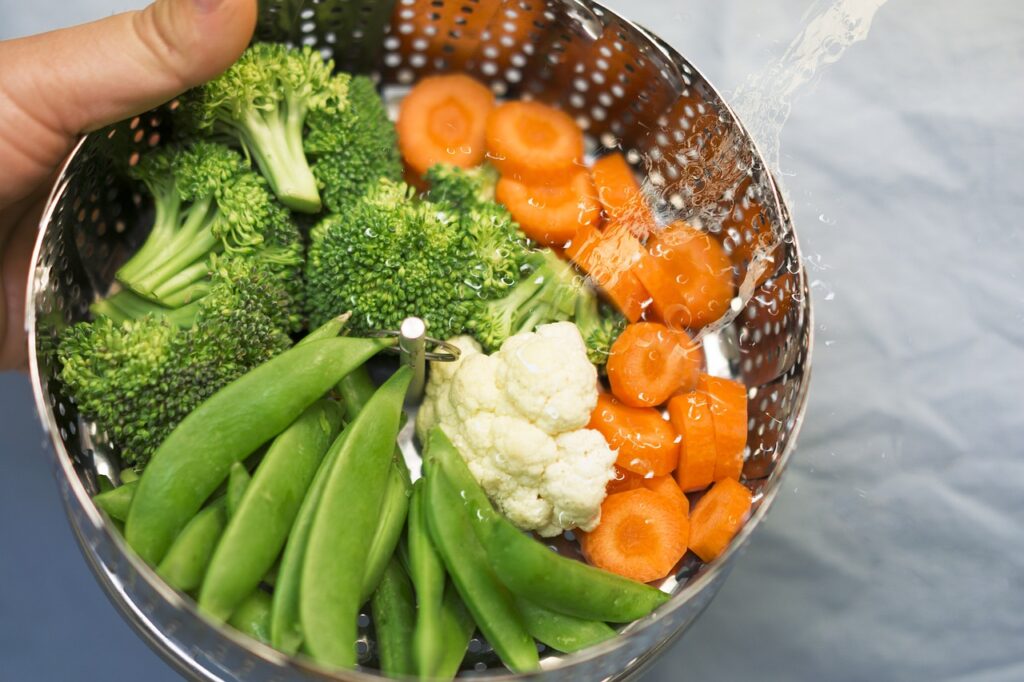Blanching is a food processing method whose objective is usually toreduce enzyme activity in foods. This process is often used to soften vegetables, fruit, nuts, or pasta before freezing or canning. It can also be used to remove the skin from some fruits or vegetables. Blanching helps to preserve color, flavor, and nutrients in the food, and can also make it easier to peel or remove the outer layers. It is very important before some processes such as drying.
Food safety knowledge is for all!

Every consumer deserves to have high quality and safe food. …Read more!

Importance of blanching food
Blanching is an important process in food preservation because it:
- Retards enzyme activity: Blanching helps to inactivate the enzymes in fruits and vegetables that can cause spoilage or discoloration. This helps to preserve the color, flavor, and nutrients of the food.
- Softens fruits and vegetables: It can be used to soften vegetables or fruits, making them easier to peel or remove the outer layers.
- Kills bacteria, viruses, and other microorganisms: Blanching can also be used to kill bacteria, viruses, and other microorganisms that may be present on the surface of fruits and vegetables.
- Sets the color: Blanching can also be used to set the color of fruits and vegetables, making them more attractive when canned or frozen.
- Improves texture: Blanching can also be used to improve the texture of fruits and vegetables by making them more tender.
- Helps in packing: Blanching helps in packing the fruits and vegetables in cans and jars as they are less likely to break or get mashed during packing.
- Reduces cooking time: Blanching can also be used to reduce the cooking time of certain foods. For example, by blanching potatoes before frying them, they will cook more quickly and evenly.
- Enhances flavor: Blanching can also be used to enhance the flavor of certain foods, such as nuts, by removing the bitter taste of their skins.
- Facilitates peeling: Blanching can make it easier to peel certain fruits and vegetables, such as tomatoes or peaches, by loosening their skin.
Types of blanching
There are several types of blanching:
- Water blanching: This is the most common method of blanching, where food is immersed in boiling water for a certain period of time and then immediately cooled in cold water or ice. This method is best for fruits and vegetables that have a high-water content, such as green beans or peaches.
- Steam blanching: This method involves immersing food in steam for a certain period of time and then immediately cooling it in cold water or ice. Steam blanching is considered a gentler method than water blanching, and is best for fruits and vegetables that are more delicate, such as asparagus or spinach.
- Microwave Blanching: This is a newer method of blanching, where the food is blanched in a microwave oven. This method is fast and easy, but it can be less effective than water or steam blanching, and it can cause uneven heating.
- Infrared blanching: This method uses infrared rays to heat the food quickly, and it is known for reducing the nutrient loss.
In summary, the type of blanching method used will depend on the type of food, the desired result and the equipment available.
Practical application of blanching techniques
Water Blanching
The steps for water blanching are:
- Prepare a large pot of water and bring it to a rolling boil.
- Prepare a large bowl of ice water.
- Add the fruits or vegetables to the boiling water, using a slotted spoon or blanching basket, and start timing.
- Remove the fruits or vegetables from the boiling water after the appropriate time and immediately place them in the ice water.
- Leave the fruits or vegetables in the ice water for the same amount of time as they were in the boiling water.
- Drain the fruits or vegetables and pat dry.
Steam Blanching
The steps for steam blanching are:
- Prepare a steamer basket or colander and place it inside a large pot with a tight-fitting lid.
- Add water to the pot, making sure it does not touch the bottom of the steamer basket or colander.
- Bring the water to a boil.
- Add the fruits or vegetables to the steamer basket or colander and cover the pot.
- Start timing and steam the fruits or vegetables until they are done.
- Remove the steamer basket or colander from the pot and place the fruits or vegetables in a bowl of ice water.
- Leave the fruits or vegetables in the ice water for the same amount of time as they were steamed.
- Drain the fruits or vegetables and pat dry.
Microwave Blanching
The steps for microwave blanching are:
- Place the fruits or vegetables in a microwave-safe dish and add a small amount of water.
- Cover the dish with microwave-safe wrap or a lid and microwave on high for the appropriate time.
- Remove the dish from the microwave and place the fruits or vegetables in a bowl of ice water.
- Leave the fruits or vegetables in the ice water for the same amount of time as they were in the microwave.
- Drain the fruits or vegetables and pat dry.
Infrared Blanching
The steps for infrared blanching are:
- Place the fruits or vegetables on a conveyor belt that is positioned under infrared heating elements.
- The conveyor belt carries the food under the infrared heating elements, which heat the food quickly.
- The food is then cooled down using water or air.
- The food is then ready to be packaged or further processed.
It’s important to note that the time and temperature for each blanching method vary depending on the type and size of the food being blanched.
Our Blog ↗
Read the latest from our blog
Ask a Question ↗
Ask a question and get answers from our community
Give Feedback ↗
We value your feedback.


